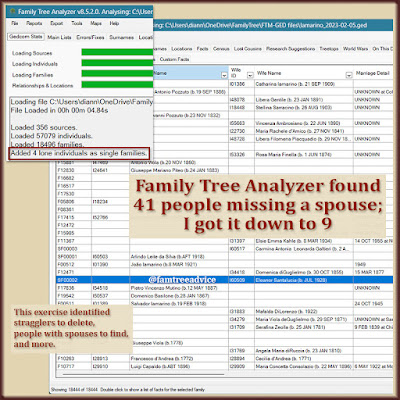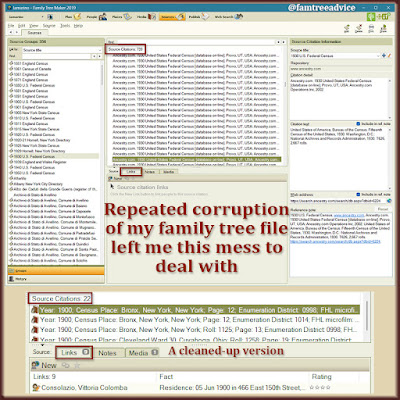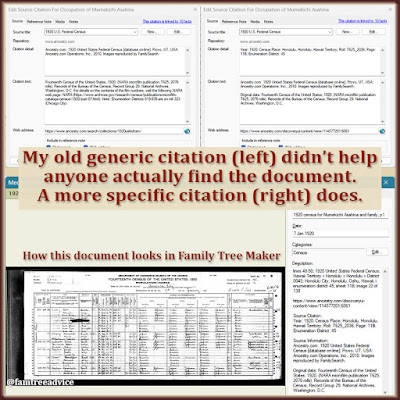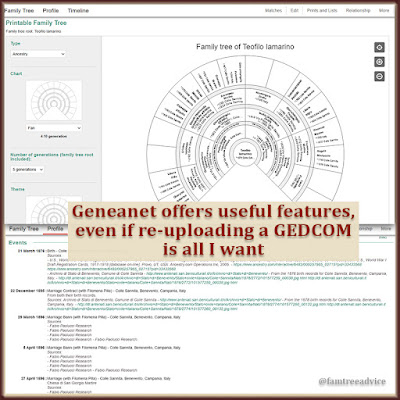Reviewing the 841 pages of censuses in my family tree has been rewarding. I've been working to clean up all my census source citations (see "Take the Time to Improve the Sources in Your Family Tree"), and it feels like I'm visiting with families I know.
For example, take the 1930 census for my grandmother's uncle Semplicio Saviano. This was the year he had a family of 3 living with him, bringing the total number of people living in his apartment to 11. The husband in that family of 3 is Patsy Ferro, and he's listed as Semplicio's nephew. But he isn't his nephew.
This mystery has been with me for a while. I must have blogged about Patsy before, because a reader named Annette wrote to me about him in 2021. She gave me a few clues about Patsy and his family. But I didn't get very far.
Finding New Clues
Last week the censuses had more to offer on this mystery. In 1940, Patsy and his wife and daughter are once again living with my Saviano relatives. Uncle Semplicio had a ton of children, and in 1940 four of them are living in the same apartment as in 1930. Patsy and his family are each listed as cousins of Semplicio's sons and daughters. But that's not true.
Of course I had to check out the 1950 census for this Saviano family. I finally found something that ties in perfectly with the story Annette told me in her 2021 email. In 1950, Patsy Ferro is the head of household, living a few doors away from his 1930 and 1940 apartment building. His wife is with him, but his daughter recently married and moved away.
Annette said that on her deathbed, Semplicio's wife asked Patsy to look after her children. She died in 1926 and Patsy did as she asked. In 1950, two of the Saviano children are living with him and his wife, listed as cousins. Mind you, they aren't children. These two Savianos are 34 and 40 years old and single.
Is There a Connection?
The question remained, though. How did my relatives know Patsy? Patsy and his wife and daughter were born in the town of Baselice, in the Italian province of Benevento. My Saviano family lived far enough from Baselice that they would never have met Patsy back home. Even Semplicio's wife was born too far from Baselice to know Patsy. But they were paesan since they all came from the province of Benevento.
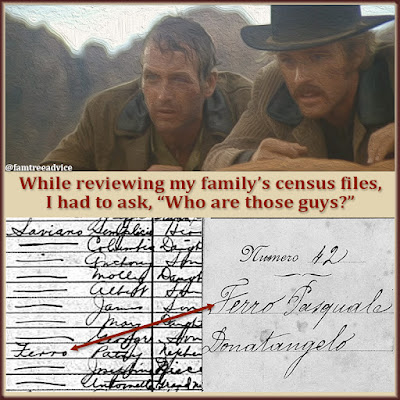 |
| Three families appeared in my family's home census after census. Who they were supports my theory about my family. |
I checked more censuses for the apartment building Semplicio co-owned with my great grandfather, Giovanni Sarracino. Patsy wasn't there in 1910 and 1920, but so many people were!
I remember this building from my childhood. There were 4 apartments, and 2 belonged to my family when I was a kid. They were "railroad apartments"—each room led straight into the next like the cars of a train. There was no hallway. You entered into the kitchen, which led to the next room, which led to the next room, which led to the master bedroom. No privacy for anyone.
But in 1920, according to the census, these 4 apartments held 5 families totaling 39 people! Three of the families are members of my extended Saviano family. The other 2 had names I recognize from the Benevento province: Campanile and Cardone. They're also in the building with my family in the 1910 and 1915 censuses. Who are they?
Was This a Pattern?
Suddenly I remembered my 2nd great grandfather, Antonio Saviano. The only photo I have of him shows him lying in his coffin in 1925 (see "1925 Death Photo Holds a Clue to My Ancestor's Life"). He's wearing a ribbon on his lapel which seems to represent an Italian mutual aid society. This group of immigrants helped other Italian immigrants thrive in their new country.
Maybe my Saviano and Sarracino relatives opened their homes to their paesan. I researched the Cardone family from the building and found some enticing details:
- Husband Francesco Cardone came from San Nicola Manfredi, Benevento. This town is NEXT DOOR to Sant'Angelo a Cupolo, the home of my Saviano and Sarracino families.
- When Francesco's wife (Maria Mirto) and daughter arrived, they called Sant'Angelo a Cupolo their hometown.
- Francesco and his wife had their first American-born child in 1906. I found his birth certificate. They lived in my family's building, and the Mrs. lists her maiden name as Maria Mirda Sarracina. Sarracina? Is this a nod to my great grandfather Giovanni Sarracino?
At the end of the day, my so-called cousin Patsy Ferro is in my family tree. Not because he's my Uncle Semplicio's nephew. He isn't. And not because he's my cousin. He isn't. He's in there because he and his wife were born in Baselice, my grandfather Leone's hometown. (Grandpa Leone is no relation to the Savianos except by marriage.) I've found that 90% of the people born in Baselice have a family relationship (see "Why I Recorded More Than 30,000 Documents").
I'm missing key pieces in both Patsy's and his wife's family trees. Until I can fill in those gaps, their closest relationship to me is through my 2nd great grandfather Leone's first wife. So that's no good.
What's the lesson here? Take a closer look at your family's census records. Are there families living with or near them, census after census? Is it a coincidence, or is there a hidden connection? You're the family-history investigator. Start digging!
